 Facebook
Facebook
 X
X
 Instagram
Instagram
 TikTok
TikTok
 Youtube
Youtube
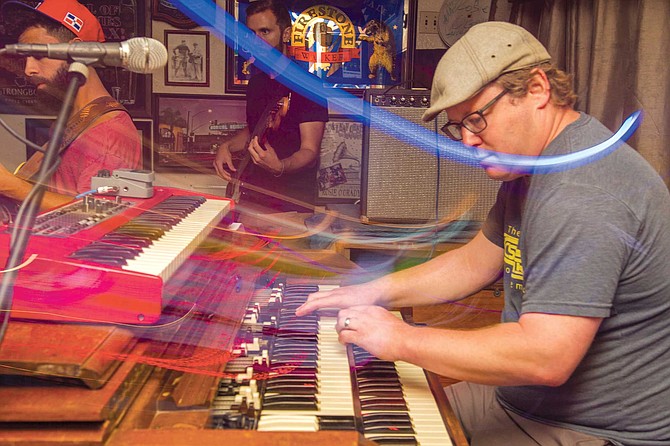
I had intended to arrive at Rosie O’ Grady’s well before the music started. Like most of life’s good intentions, that plan was thwarted by a personal inertia more powerful than wishful thinking. As I approached the bar on Adams Avenue in Normal Heights, I could already hear the music pumping and the ricochet of the snare drum backbeat from several blocks away. “This is gonna be a nightmare to find parking,” I thought, but I was able to immediately coast into a space on 34th Street, literally inches from the front door.
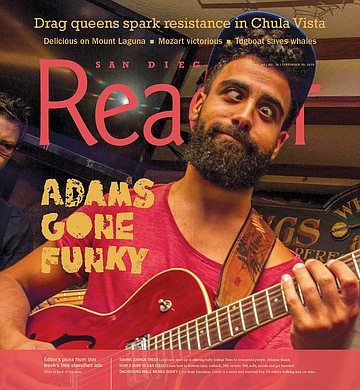
Before crossing the threshold, I stopped to peer inside. The place was packed to the gills, and seating prospects did not appear promising. A large man in a black shirt soon let me know that standing in front of the entrance was not advisable, and that I needed to make a decision.
The musicians were set up just inside the door, and I had to squeeze between the saxophone player and bandleader Tim Felten’s massive Hammond organ to snake my way towards the back wall where one table stood empty.
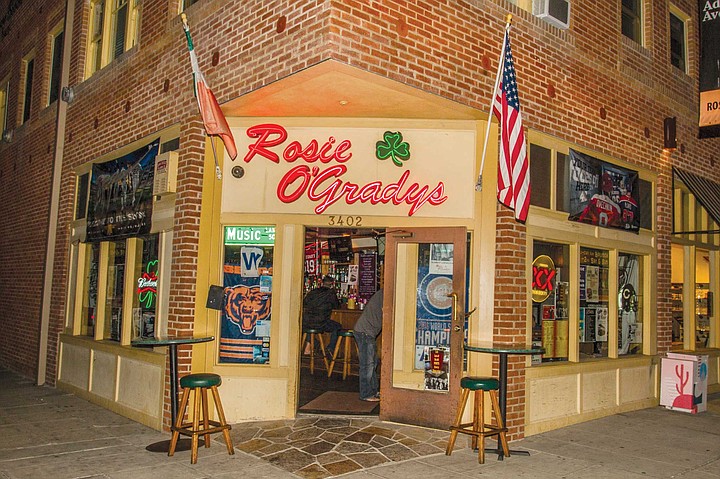
I glanced down at my watch; it read 8:43. It was dark and loud with gritty funk music, and the drone of conversations powered by whiskey, beer, and youthful pheromones.
It took a minute to get used to the volume of it all. My guess is the crowd was pumping out about 110 decibels and the band about 120. I could feel the walls shake and the floor vibrate. The band navigated through a gutbucket version of Grant Green’s “Upshot,” and after some personnel introductions that wafted inaudibly into the night, launched into “Burning Spear,” with a blistering guitar solo by David Carano. I could just make out the figure of Ricky Giordano on bass (he and Carano would switch off on instruments most of the night.)
At first, I didn’t think anyone was listening, but a round of applause seemed to erupt between tunes and following impressive solos. That was noteworthy. Although I lost count at seven large-screen TV’s — mostly showing Major League Baseball games or ESPN shows — no one seemed to watch them, and if the volume was up on any of them I couldn’t tell. I started to do a body count (50 and growing if my math was correct). I’m not an expert witness, but I’d say the average patron ranged from early twenties to mid-thirties.
By 9:30, the place was completely packed. On the rare occasion that patrons headed for the front door, their seats were immediately occupied by someone who had been standing. Matt LaBarber (who used to play bass in Felten’s other band, the Sure Fire Soul Ensemble) came in to spell Carano and Jake Najor arrived from a competing gig to relieve Chris Cancelliere on drums.
Why has Adams gone funky?

Tim Felten runs the Tuesday jam session at Rosie O’ Grady’s, and it was through his invitation that I decided to investigate. The lure was the promise of a different kind of jam-session, one centered around the acquisition of a 70-year-old Hammond C-3 organ. In the 1960s, Hammond organs were as common as napkins in most nightclubs. They relieved the owners from the expense and upkeep of a functioning acoustic grand piano.
But that was in the Hammond’s heyday. According to Felten, the instrument he parks at Rosie O’ Grady’s is the only house organ he knows of south of San Francisco. “To my knowledge, that is true,” says Felten, a stocky fellow in his early-forties with thick glasses. “It’s probably been decades since San Diego had a club with a house organ, where it was just set up, ready to play — until now.”
Felten has a personal Hammond that he leaves in his home recording studio, but the horror of moving an organ from home to gigs is a routine he abandoned several years ago.
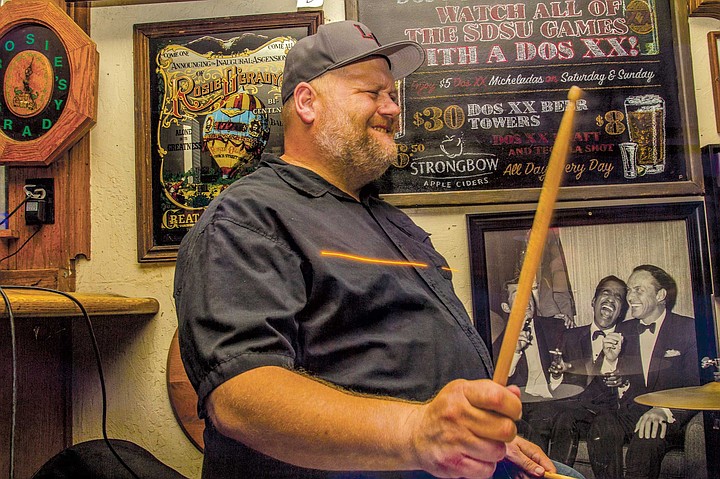
“First of all you need a van,” says Felten. “Between the organ itself, which weighs at least 350 pounds” — Wikipedia says 425 — “and the Leslie speaker, which is another hundred or so, a van is necessary. Plus, you need help loading it in from home and loading it out at the nightclub, and then in reverse. It’s literally a pain-in-the-neck.”
Between the Hammond and the Leslie speaker (which features a revolving tweeter in a wooden cabinet that gives it a distinct sound) Felten’s rig takes up as much space as a picnic table, but less than a city bus.
Why go through all of that hassle when there are plenty of lightweight, portable alternatives available? I wondered why the allure of an instrument created in the 1930’s remains so powerful to Felten and his peers. “I fell in love with the idea after our band played at this club in San Francisco called the Boom Boom Room, where they had a house organ, and it just felt so good.”
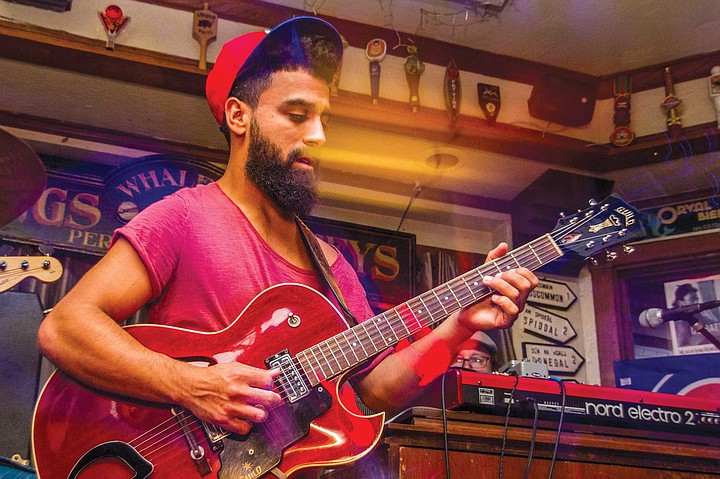
“It’s like the difference between playing a plastic guitar and a real one. The real Hammond has motors — it’s all hand-wired — the instrument sounds are produced electro-mechanically. You literally have to warm it up before it produces a sound. And, I’m not joking, you have to add oil to it.”
So how did the opportunity to acquire this instrument and have it live at Rosie O’ Grady’s come to him?
“I have to give an enormous amount of credit to Jason Rammelsberg, the general manager of the club,” says Felten. “He approached me about doing music on a Tuesday night, which had been very slow for the venue, and I came back with the idea for a Hammond organ night.”
This thing has really taken off
“Tim had this idea to bring a Hammond and a Leslie speaker in for a soul-jazz night,” says Rammelsberg. “And I was thinking maybe Rosie’s was too small, but I brought in a measuring tape…”
And, as it turns out, there was just enough space to set Felten’s Hammond C-3 and a Leslie speaker right inside the front door at Rosie O’ Grady’s . When it’s not being played, they wheel the instrument into the back of the bar by the 24-hour teller machine, while the Leslie sneaks off to a small utility room with just inches to spare.
I caught up with Rammelsberg, (a forty-ish cat with a beard and tattoos who wore glasses and a baseball cap) to get some inside dope about the organ night at Rosie’s, and his own personal history with the club. Rammelsberg came to San Diego from St. Louis, where he spent six years learning the bar business. But he grew up in Chicago. His dad, Michael Rammelsberg, had already been in San Diego a few years when he bought Rosie’s and gave Jason a call. There were significant growing pains initially.
“I spent the first year or so kicking out all of the riffraff and that good stuff,” says Rammelsberg. “There were a lot of crackheads and prostitutes. This was 17 years ago. And the Normal Heights area was pretty blighted. But we saw the potential, and as the neighborhood built up, people would visit the bar and fall in love with the neighborhood, especially younger people.”
So how would he characterize Rosie’s as an establishment? “It’s a neighborhood place... It’s a bar that has good music, as opposed to being a venue. We have a lot of regulars who live in the area and walk to the place. It’s a nice mix of young, college-age folks and professionals and older people who usually populate in the daytime. It’s a different crowd for happy hour, and as the sun goes down, the demographic gets younger.”
Tuesday nights are typically slow for bars, and it seems like bringing music in carried a degree of risk. Has it paid off so far? “Yes, for sure,” Rammelsberg replied. “This thing has really taken off. Now we have all the neighborhood regulars plus this large contingency of musicians and their girlfriends, and the place is slamming on Mondays,” when guitarist Louis Valenzuela has a jazz jam-session “and Tuesdays for the organ-jam. It’s kind of like a house party where everyone loves to hang out with friends and family, and people just gravitate towards that.”
The times I’ve been there seemed like the beginnings of a genuine scene. People dance towards the front, and I saw patrons making cell-phone videos while they grooved along. A table next to mine filled up with four ladies who swayed to and fro to the music with their eyes closed.
“Like I said, the whole neighborhood has been really receptive to it,” says Rammelsberg. “The Business Association has even pitched in and promoted it on their website. It’s all about getting people off of their cell phones and being connected to this larger thing.”
Both nights I was at the organ-jam featured the sweet and friendly bartender Michaela Van Wulven, a 28-year-old who has worked for six years for the Rammelsberg family, although she’s only been at Rosie’s for six months. How would she describe the scene and the club in general?
“This is a very open bar,” says Van Wulven. “Anyone can come here for a good time. They welcome all genres of music, all kinds of musicians from all walks of life — they give everyone a chance to show what they can do. Everyone around here knows Rosie’s.... It’s kind of like Cheers in a way.”
How has the Tuesday night experience evolved with since the organ jam sessions started? “It’s definitely brought a bunch of people in from outside the neighborhood,” Van Wulven answered. “Before, it was kind of slow. Now that people know about the band being here every Tuesday, the crowds are much bigger. I love it because the more people, the more money.”
It’s Van Wulven’s job to check the IDs. I asked her, “What’s the average age of a Rosie’s patron?”
“Probably 25 to 50. The older people start to filter out around 9 or 10. The later it gets, the younger the crowd becomes. It stays pretty rocking in here until the band packs up around midnight, then people chill out and head home.”
Jazz used to be the music of dancers way back in the swing era, when the hippest bands played for couples doing the jitterbug. But since the advent of bebop in the late 1940s, that association died out. I asked Felten if the scene I witnessed my first time out was an anomaly, or a regular occurrence?
“Well the style of music that we play is definitely dance music.” Felten said. “That’s kind of the point of soul-jazz. There’s no more dance-floor friendly music than this. Soul-jazz is kind of hard to define, but it feels to me like we’re doing it for something bigger than ourselves — for a deeper communal reason. It’s almost like being in church. The Hammond organ has a deep link to the church. I’m not really religious in the traditional sense, but it feels like church to me.”
Pulling out all the stops
Ever wonder where that expression came from? It’s a reference that can be traced back to the pipe organ days. When the player pulls out a “stop,” the instrument gets more air and becomes louder. When all of the stops are pulled out, the instrument is at full capacity. It has come to mean that one has given one’s all, but it has its roots in the pre-Hammond, pipe-organ days.
According to Felten, there were several people responsible for acquiring the Hammond C-3 that now calls Rosie’s home. Felten paid for most of it, but he also enlisted help from fellow organ specialists Bobby Cressey (who plays for the San Diego Padres and San Diego Gulls) and Ed Kornhauser as investors. Another key investor is Paul Spees, a local organ-repair person — on board for maintenance issues.
But the person mainly responsible for the organ at Rosie’s is Dave Chesavage, president of Ocean Beach Digital. Chesavage bought the Hammond C-3 many years ago when he was still in college.
“I was in a band called the Travel Agents back then,” Chesavage recalled. “A friend of ours was starting a festival down in Mexico called the Baja Bash, and we were invited to play. The headliner that year was Merle Saunders, who used to play with Jerry Garcia. It was a fly-in gig for them, so they needed backline equipment.” Instruments and amplifiers to be supplied by the promoter. “Somehow, I was put in charge of renting a Hammond organ. I soon found out that no one on this side of the border was willing to rent to someone taking the instrument into Mexico.
“So I looked into finding one through the classifieds in the Reader, and just missed out on a few. Eventually, I found this guy Bob Blake, who had a warehouse full of organs. I came to look at a different instrument, but I noticed a C-3 sitting in the corner. The C-3 is the cabinet made to put in churches. After I played it, I was smitten, and that was that.”
Chesavage used the C-3 as a backline instrument for ten more versions of the Baja Fest, but by 2006, it was starting to take up space at home, and he wasn’t using it as much. Part of the problem was the logistics and muscle-power involved.
“I mean, the organ itself weighs 425 pounds without the Leslie speaker. It takes four guys and specialized dollies to move it, so I wasn’t really into taking it to gigs. I had paid $1500 initially for it, but I ended up putting another $2000 into it, plus the dolly cost another five hundred bucks.”
So how did the instrument end up at Rosie’s?
“I saw a post that Tim had made on Facebook about really wanting to set up a house organ in a nightclub, and I knew I should reach out. It was a hard instrument to part with. I took a huge loss on it financially — but I did get a lot of use out of it for 15 or 20 years, so there’s that. The first time I went to Rosie’s and heard the music coming out of it, I knew I had made the right decision — all of my misgivings dissipated. This is absolutely the best place for it to be, and I know that I did the right thing.”
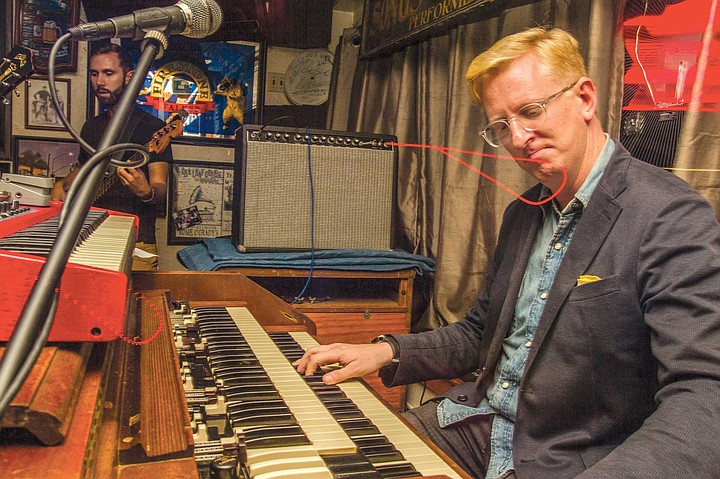
I reached out to both Bobby Cressey and Ed Kornhauser to see why they considered going in on a 70-year-old instrument to be a prudent investment.
“What if you told a sax player, that they couldn’t play a real instrument — only some electronic version that simulated the sound of an actual saxophone?” queried Cressey. “As absurd as that sounds, this is exactly what organists have to do when they aren’t playing a real Hammond organ. The Hammond is an electronic behemoth with a complex signal chain of tonewheels, amps, pre-amps, tubes, and that rotating Leslie speaker. Each component contributes to that signature sound, and this is all very difficult to replicate on a portable keyboard.
“Tim has been trying for years to get a venue in San Diego to have a real instrument. He scouted the locations, talked to the venues, did all of his homework. He found the instrument. He put up his own money. The rest of us just chipped in, really. When he approached us about putting in some dollars, I knew I had to do it. These are my fellow keyboardists, and I want to be in solidarity with them. Things are always better in this scene when we all work together. Now, finally, San Diego has a venue with a house organ. This means we can bring other players to town and we have a spot for them to perform. This elevates the scene in so many ways. We can do jazz organ trio nights, funk jams like Tim’s, and anything else that uses a real Hammond.”
Kornhauser is one of the busiest musicians in town, often going from one gig to the next and another in what has been called the “Kornhauser shuffle.” Most of the time, he plays the piano, but he’s got a thing for playing the organ as well, which brought him on board.
“I really like the scene we’ve got here in San Diego, and I was happy to make an investment in it,” said Kornhauser. “Having a club with a house Hammond is huge for all of us. It adds a warmth and fuzziness to everything. Tim is really the main cat. He found this great instrument and put his own money up. I’ve chipped in since, and I plan to keep chipping in more and more as time goes by for upkeep and whatnot. Hopefully it will attract a new class of bands to play there — both local people and touring acts. Jason over at Rosie’s is really in the San Diego music scene’s corner. He believed in us, and the organ is further proof of that.”
Back at Rosie’s
I returned to Rosie O’ Grady’s two weeks later. This time, I made sure to leave my house in North Park with plenty of time to grab a premium table. I arrived at about quarter to eight, just as the lazy sun began to set in the western horizon.
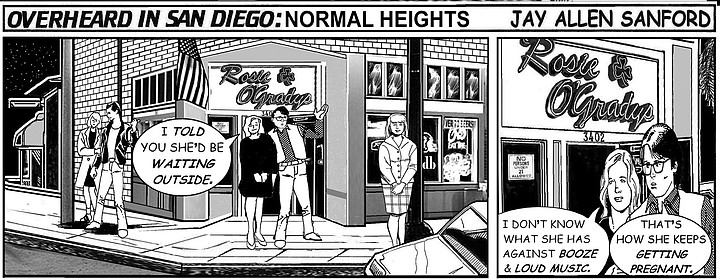
I sat right in front. One of the big motivations for returning to the Normal Heights neighborhood hang was the opportunity to catch Felten and the house band at full capacity. Everyone playing that night was a permanent member of the band, which features Ricky Giordano on bass (and guitar when called for) utility man Travis Klein on guitar, tenor saxophone and flute, and the relentless backbeat of Jake Najor on drums, who has the power to elevate the groove of every band he’s a part of.
By 8:15, there were about 20 bodies in the place, mostly sitting along the bar. Immediately adjacent to me, two couples in their twenties sat down and we exchanged niceties. My table was positioned directly below a powerful ceiling fan, and between that and the air conditioning, excessive heat would not be an issue on this warm summer night.
Rammelsberg appeared to be in deep, animated conversation with several regulars from behind the bar, while Van Wulven buzzed around him keeping drinks fresh.
As the place filled up, I asked Jason what the absolute capacity of Rosie’s is. “The Fire Marshall says our maximum occupancy is at 115 people,” said Rammelsberg, shouting over the growing din. I made an observation about being shoulder-to-shoulder, and he corrected me with bartender lingo. “No, 115 is what we call ‘nuts-to-butts.’ That’s a good sign in our business.”
I looked around; the bar seemed to have an 80/20 ratio of men to women. On the male contingent, t-shirts, beards, and baseball caps dominate. The women’s attire seemed divided between colorful summer dresses and jeans-and-tank-top combos.
At 8:29 the band filtered in and they launched into the blistering funk of Felten’s original tune, “Campus Life,” which reminded me a lot of James Brown’s mid-’70s work.
I had a birds-eye view of the entrance, through which patrons entered by twos and threes in a steady stream. By 9:30, the place was almost full, maybe not ‘nuts-to-butts’ yet, but getting closer as each minute passed. As the night wore on, Felten’s generosity on the bandstand became more obvious. Three different bass players sat in for a few tunes a piece, and two organ players made their way to the stage to jam out on grooves like Joe Zawinul’s “Mercy, Mercy, Mercy,” and Quincy Jones’ “Hikky Burr.” At all times, the groove was the imperative.
I got the chance to ask Felten what he hoped this Tuesday night organ jam session would ultimately become. “I guess I hope that we keep getting great crowds and that people have a good time and derive some satisfaction from it. They can come here and just immerse themselves in the music. I hope that many other bands will be able to book themselves at Rosie’s and make good use of the organ here.”


I had intended to arrive at Rosie O’ Grady’s well before the music started. Like most of life’s good intentions, that plan was thwarted by a personal inertia more powerful than wishful thinking. As I approached the bar on Adams Avenue in Normal Heights, I could already hear the music pumping and the ricochet of the snare drum backbeat from several blocks away. “This is gonna be a nightmare to find parking,” I thought, but I was able to immediately coast into a space on 34th Street, literally inches from the front door.

Before crossing the threshold, I stopped to peer inside. The place was packed to the gills, and seating prospects did not appear promising. A large man in a black shirt soon let me know that standing in front of the entrance was not advisable, and that I needed to make a decision.
The musicians were set up just inside the door, and I had to squeeze between the saxophone player and bandleader Tim Felten’s massive Hammond organ to snake my way towards the back wall where one table stood empty.

I glanced down at my watch; it read 8:43. It was dark and loud with gritty funk music, and the drone of conversations powered by whiskey, beer, and youthful pheromones.
It took a minute to get used to the volume of it all. My guess is the crowd was pumping out about 110 decibels and the band about 120. I could feel the walls shake and the floor vibrate. The band navigated through a gutbucket version of Grant Green’s “Upshot,” and after some personnel introductions that wafted inaudibly into the night, launched into “Burning Spear,” with a blistering guitar solo by David Carano. I could just make out the figure of Ricky Giordano on bass (he and Carano would switch off on instruments most of the night.)
At first, I didn’t think anyone was listening, but a round of applause seemed to erupt between tunes and following impressive solos. That was noteworthy. Although I lost count at seven large-screen TV’s — mostly showing Major League Baseball games or ESPN shows — no one seemed to watch them, and if the volume was up on any of them I couldn’t tell. I started to do a body count (50 and growing if my math was correct). I’m not an expert witness, but I’d say the average patron ranged from early twenties to mid-thirties.
By 9:30, the place was completely packed. On the rare occasion that patrons headed for the front door, their seats were immediately occupied by someone who had been standing. Matt LaBarber (who used to play bass in Felten’s other band, the Sure Fire Soul Ensemble) came in to spell Carano and Jake Najor arrived from a competing gig to relieve Chris Cancelliere on drums.
Why has Adams gone funky?

Tim Felten runs the Tuesday jam session at Rosie O’ Grady’s, and it was through his invitation that I decided to investigate. The lure was the promise of a different kind of jam-session, one centered around the acquisition of a 70-year-old Hammond C-3 organ. In the 1960s, Hammond organs were as common as napkins in most nightclubs. They relieved the owners from the expense and upkeep of a functioning acoustic grand piano.
But that was in the Hammond’s heyday. According to Felten, the instrument he parks at Rosie O’ Grady’s is the only house organ he knows of south of San Francisco. “To my knowledge, that is true,” says Felten, a stocky fellow in his early-forties with thick glasses. “It’s probably been decades since San Diego had a club with a house organ, where it was just set up, ready to play — until now.”
Felten has a personal Hammond that he leaves in his home recording studio, but the horror of moving an organ from home to gigs is a routine he abandoned several years ago.

“First of all you need a van,” says Felten. “Between the organ itself, which weighs at least 350 pounds” — Wikipedia says 425 — “and the Leslie speaker, which is another hundred or so, a van is necessary. Plus, you need help loading it in from home and loading it out at the nightclub, and then in reverse. It’s literally a pain-in-the-neck.”
Between the Hammond and the Leslie speaker (which features a revolving tweeter in a wooden cabinet that gives it a distinct sound) Felten’s rig takes up as much space as a picnic table, but less than a city bus.
Why go through all of that hassle when there are plenty of lightweight, portable alternatives available? I wondered why the allure of an instrument created in the 1930’s remains so powerful to Felten and his peers. “I fell in love with the idea after our band played at this club in San Francisco called the Boom Boom Room, where they had a house organ, and it just felt so good.”

“It’s like the difference between playing a plastic guitar and a real one. The real Hammond has motors — it’s all hand-wired — the instrument sounds are produced electro-mechanically. You literally have to warm it up before it produces a sound. And, I’m not joking, you have to add oil to it.”
So how did the opportunity to acquire this instrument and have it live at Rosie O’ Grady’s come to him?
“I have to give an enormous amount of credit to Jason Rammelsberg, the general manager of the club,” says Felten. “He approached me about doing music on a Tuesday night, which had been very slow for the venue, and I came back with the idea for a Hammond organ night.”
This thing has really taken off
“Tim had this idea to bring a Hammond and a Leslie speaker in for a soul-jazz night,” says Rammelsberg. “And I was thinking maybe Rosie’s was too small, but I brought in a measuring tape…”
And, as it turns out, there was just enough space to set Felten’s Hammond C-3 and a Leslie speaker right inside the front door at Rosie O’ Grady’s . When it’s not being played, they wheel the instrument into the back of the bar by the 24-hour teller machine, while the Leslie sneaks off to a small utility room with just inches to spare.
I caught up with Rammelsberg, (a forty-ish cat with a beard and tattoos who wore glasses and a baseball cap) to get some inside dope about the organ night at Rosie’s, and his own personal history with the club. Rammelsberg came to San Diego from St. Louis, where he spent six years learning the bar business. But he grew up in Chicago. His dad, Michael Rammelsberg, had already been in San Diego a few years when he bought Rosie’s and gave Jason a call. There were significant growing pains initially.
“I spent the first year or so kicking out all of the riffraff and that good stuff,” says Rammelsberg. “There were a lot of crackheads and prostitutes. This was 17 years ago. And the Normal Heights area was pretty blighted. But we saw the potential, and as the neighborhood built up, people would visit the bar and fall in love with the neighborhood, especially younger people.”
So how would he characterize Rosie’s as an establishment? “It’s a neighborhood place... It’s a bar that has good music, as opposed to being a venue. We have a lot of regulars who live in the area and walk to the place. It’s a nice mix of young, college-age folks and professionals and older people who usually populate in the daytime. It’s a different crowd for happy hour, and as the sun goes down, the demographic gets younger.”
Tuesday nights are typically slow for bars, and it seems like bringing music in carried a degree of risk. Has it paid off so far? “Yes, for sure,” Rammelsberg replied. “This thing has really taken off. Now we have all the neighborhood regulars plus this large contingency of musicians and their girlfriends, and the place is slamming on Mondays,” when guitarist Louis Valenzuela has a jazz jam-session “and Tuesdays for the organ-jam. It’s kind of like a house party where everyone loves to hang out with friends and family, and people just gravitate towards that.”
The times I’ve been there seemed like the beginnings of a genuine scene. People dance towards the front, and I saw patrons making cell-phone videos while they grooved along. A table next to mine filled up with four ladies who swayed to and fro to the music with their eyes closed.
“Like I said, the whole neighborhood has been really receptive to it,” says Rammelsberg. “The Business Association has even pitched in and promoted it on their website. It’s all about getting people off of their cell phones and being connected to this larger thing.”
Both nights I was at the organ-jam featured the sweet and friendly bartender Michaela Van Wulven, a 28-year-old who has worked for six years for the Rammelsberg family, although she’s only been at Rosie’s for six months. How would she describe the scene and the club in general?
“This is a very open bar,” says Van Wulven. “Anyone can come here for a good time. They welcome all genres of music, all kinds of musicians from all walks of life — they give everyone a chance to show what they can do. Everyone around here knows Rosie’s.... It’s kind of like Cheers in a way.”
How has the Tuesday night experience evolved with since the organ jam sessions started? “It’s definitely brought a bunch of people in from outside the neighborhood,” Van Wulven answered. “Before, it was kind of slow. Now that people know about the band being here every Tuesday, the crowds are much bigger. I love it because the more people, the more money.”
It’s Van Wulven’s job to check the IDs. I asked her, “What’s the average age of a Rosie’s patron?”
“Probably 25 to 50. The older people start to filter out around 9 or 10. The later it gets, the younger the crowd becomes. It stays pretty rocking in here until the band packs up around midnight, then people chill out and head home.”
Jazz used to be the music of dancers way back in the swing era, when the hippest bands played for couples doing the jitterbug. But since the advent of bebop in the late 1940s, that association died out. I asked Felten if the scene I witnessed my first time out was an anomaly, or a regular occurrence?
“Well the style of music that we play is definitely dance music.” Felten said. “That’s kind of the point of soul-jazz. There’s no more dance-floor friendly music than this. Soul-jazz is kind of hard to define, but it feels to me like we’re doing it for something bigger than ourselves — for a deeper communal reason. It’s almost like being in church. The Hammond organ has a deep link to the church. I’m not really religious in the traditional sense, but it feels like church to me.”
Pulling out all the stops
Ever wonder where that expression came from? It’s a reference that can be traced back to the pipe organ days. When the player pulls out a “stop,” the instrument gets more air and becomes louder. When all of the stops are pulled out, the instrument is at full capacity. It has come to mean that one has given one’s all, but it has its roots in the pre-Hammond, pipe-organ days.
According to Felten, there were several people responsible for acquiring the Hammond C-3 that now calls Rosie’s home. Felten paid for most of it, but he also enlisted help from fellow organ specialists Bobby Cressey (who plays for the San Diego Padres and San Diego Gulls) and Ed Kornhauser as investors. Another key investor is Paul Spees, a local organ-repair person — on board for maintenance issues.
But the person mainly responsible for the organ at Rosie’s is Dave Chesavage, president of Ocean Beach Digital. Chesavage bought the Hammond C-3 many years ago when he was still in college.
“I was in a band called the Travel Agents back then,” Chesavage recalled. “A friend of ours was starting a festival down in Mexico called the Baja Bash, and we were invited to play. The headliner that year was Merle Saunders, who used to play with Jerry Garcia. It was a fly-in gig for them, so they needed backline equipment.” Instruments and amplifiers to be supplied by the promoter. “Somehow, I was put in charge of renting a Hammond organ. I soon found out that no one on this side of the border was willing to rent to someone taking the instrument into Mexico.
“So I looked into finding one through the classifieds in the Reader, and just missed out on a few. Eventually, I found this guy Bob Blake, who had a warehouse full of organs. I came to look at a different instrument, but I noticed a C-3 sitting in the corner. The C-3 is the cabinet made to put in churches. After I played it, I was smitten, and that was that.”
Chesavage used the C-3 as a backline instrument for ten more versions of the Baja Fest, but by 2006, it was starting to take up space at home, and he wasn’t using it as much. Part of the problem was the logistics and muscle-power involved.
“I mean, the organ itself weighs 425 pounds without the Leslie speaker. It takes four guys and specialized dollies to move it, so I wasn’t really into taking it to gigs. I had paid $1500 initially for it, but I ended up putting another $2000 into it, plus the dolly cost another five hundred bucks.”
So how did the instrument end up at Rosie’s?
“I saw a post that Tim had made on Facebook about really wanting to set up a house organ in a nightclub, and I knew I should reach out. It was a hard instrument to part with. I took a huge loss on it financially — but I did get a lot of use out of it for 15 or 20 years, so there’s that. The first time I went to Rosie’s and heard the music coming out of it, I knew I had made the right decision — all of my misgivings dissipated. This is absolutely the best place for it to be, and I know that I did the right thing.”

I reached out to both Bobby Cressey and Ed Kornhauser to see why they considered going in on a 70-year-old instrument to be a prudent investment.
“What if you told a sax player, that they couldn’t play a real instrument — only some electronic version that simulated the sound of an actual saxophone?” queried Cressey. “As absurd as that sounds, this is exactly what organists have to do when they aren’t playing a real Hammond organ. The Hammond is an electronic behemoth with a complex signal chain of tonewheels, amps, pre-amps, tubes, and that rotating Leslie speaker. Each component contributes to that signature sound, and this is all very difficult to replicate on a portable keyboard.
“Tim has been trying for years to get a venue in San Diego to have a real instrument. He scouted the locations, talked to the venues, did all of his homework. He found the instrument. He put up his own money. The rest of us just chipped in, really. When he approached us about putting in some dollars, I knew I had to do it. These are my fellow keyboardists, and I want to be in solidarity with them. Things are always better in this scene when we all work together. Now, finally, San Diego has a venue with a house organ. This means we can bring other players to town and we have a spot for them to perform. This elevates the scene in so many ways. We can do jazz organ trio nights, funk jams like Tim’s, and anything else that uses a real Hammond.”
Kornhauser is one of the busiest musicians in town, often going from one gig to the next and another in what has been called the “Kornhauser shuffle.” Most of the time, he plays the piano, but he’s got a thing for playing the organ as well, which brought him on board.
“I really like the scene we’ve got here in San Diego, and I was happy to make an investment in it,” said Kornhauser. “Having a club with a house Hammond is huge for all of us. It adds a warmth and fuzziness to everything. Tim is really the main cat. He found this great instrument and put his own money up. I’ve chipped in since, and I plan to keep chipping in more and more as time goes by for upkeep and whatnot. Hopefully it will attract a new class of bands to play there — both local people and touring acts. Jason over at Rosie’s is really in the San Diego music scene’s corner. He believed in us, and the organ is further proof of that.”
Back at Rosie’s
I returned to Rosie O’ Grady’s two weeks later. This time, I made sure to leave my house in North Park with plenty of time to grab a premium table. I arrived at about quarter to eight, just as the lazy sun began to set in the western horizon.

I sat right in front. One of the big motivations for returning to the Normal Heights neighborhood hang was the opportunity to catch Felten and the house band at full capacity. Everyone playing that night was a permanent member of the band, which features Ricky Giordano on bass (and guitar when called for) utility man Travis Klein on guitar, tenor saxophone and flute, and the relentless backbeat of Jake Najor on drums, who has the power to elevate the groove of every band he’s a part of.
By 8:15, there were about 20 bodies in the place, mostly sitting along the bar. Immediately adjacent to me, two couples in their twenties sat down and we exchanged niceties. My table was positioned directly below a powerful ceiling fan, and between that and the air conditioning, excessive heat would not be an issue on this warm summer night.
Rammelsberg appeared to be in deep, animated conversation with several regulars from behind the bar, while Van Wulven buzzed around him keeping drinks fresh.
As the place filled up, I asked Jason what the absolute capacity of Rosie’s is. “The Fire Marshall says our maximum occupancy is at 115 people,” said Rammelsberg, shouting over the growing din. I made an observation about being shoulder-to-shoulder, and he corrected me with bartender lingo. “No, 115 is what we call ‘nuts-to-butts.’ That’s a good sign in our business.”
I looked around; the bar seemed to have an 80/20 ratio of men to women. On the male contingent, t-shirts, beards, and baseball caps dominate. The women’s attire seemed divided between colorful summer dresses and jeans-and-tank-top combos.
At 8:29 the band filtered in and they launched into the blistering funk of Felten’s original tune, “Campus Life,” which reminded me a lot of James Brown’s mid-’70s work.
I had a birds-eye view of the entrance, through which patrons entered by twos and threes in a steady stream. By 9:30, the place was almost full, maybe not ‘nuts-to-butts’ yet, but getting closer as each minute passed. As the night wore on, Felten’s generosity on the bandstand became more obvious. Three different bass players sat in for a few tunes a piece, and two organ players made their way to the stage to jam out on grooves like Joe Zawinul’s “Mercy, Mercy, Mercy,” and Quincy Jones’ “Hikky Burr.” At all times, the groove was the imperative.
I got the chance to ask Felten what he hoped this Tuesday night organ jam session would ultimately become. “I guess I hope that we keep getting great crowds and that people have a good time and derive some satisfaction from it. They can come here and just immerse themselves in the music. I hope that many other bands will be able to book themselves at Rosie’s and make good use of the organ here.”
Comments